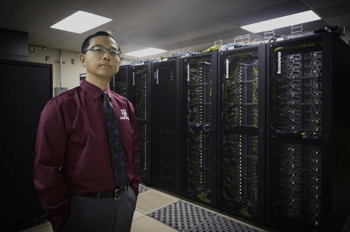Texas A&M Launches Supercomputer With 10 Times The Power Of Predecessor

Researchers at Texas A&M University can now take on a whole new class of high-level scientific problems, thanks to a newly installed $2.1 million supercomputer that offers 10 times the processing power of its predecessor, announced Division of Research officials.
This increase in computational power will support projects that include developing new materials, discovering new drugs, forecasting storm surges and managing energy resources, the officials state.
Nicknamed “Terra,” the Latin name for Earth, the new system will produce faster results with greater accuracy while enhancing Texas A&M’s long-standing national reputation in supercomputing, according to Honggao Liu, director of the Division’s High Performance Research Computing. “Terra represents a new supercomputer iteration deployed at Texas A&M,” Liu said. “Our goal is to provide Terra’s services to Texas A&M scientists and engineers who are tackling complex problems that often require the use of 1,000 or more computational cores at once.”
Supercomputers use a large number of computational cores, which connect through a high-speed network to run multiple calculations at once or collaborate on a single problem. Researchers employ supercomputers for large-scale numerical modeling and simulations. The machines tackle problems that are too complicated or time-consuming for standard computers. Terra’s power allows it to simultaneously operate far more complex projects than its predecessor could handle. Such power is measured in how many “flops,” or floating-point operations, a computer can process in one second. A flop is any number with a decimal point. A “teraflop” is a trillion flops. At peak performance, Terra can handle more than 397 teraflops per second.
Texas A&M purchased its first supercomputer in 1989 and generally operates two on the A&M campus. The oldest is replaced every three to four years. Terra replaces the supercomputer Eos, which was launched in 2009, and is funded primarily through a joint effort of the Division of Research and the College of Geosciences.
Glen A. Laine, vice president for research, said, “Texas A&M has adopted and is steadily implementing a strategic vision for High Performance Research Computing, assigning it a central role in research and education. Building upon the previous investment in computer resources provided by Chancellor John Sharp of The Texas A&M University System, Terra will greatly expand the supercomputing capacity for the University and strengthen A&M’s national standing in this area.”
Jack Baldauf, executive associate dean and associate dean for research in the College of Geosciences, said, “With the processing power of Terra, the faculty and researchers in the College of Geosciences will get results more quickly and more accurately than ever before. In addition, Terra will encourage our researchers across campus to seek out and engage in cutting-edge, interdisciplinary projects.”
Built by multinational technology company Lenovo, the Terra system features a total of 304 compute nodes, each of which has two Intel Broadwell 14-core processors running at 2.4 gigahertz for a total of 8,512 computational cores. While 256 nodes have 64 gigabytes of memory, 48 are equipped with 128 gigabytes each. Forty-eight nodes are each equipped with one NVIDIA Kepler K80 graphical processing unit. The new system has an Intel Omni-Path Architecture interconnection network and one petabyte of high-performance storage.
About Research At Texas A&M University:
As one of the world’s leading research institutions, Texas A&M is at the forefront in making significant contributions to scholarship and discovery, including that of science and technology. Research conducted at Texas A&M represented annual expenditures of more than $866.6 million in fiscal year 2015. Texas A&M ranked in the top 20 of the National Science Foundation’s Higher Education Research and Development survey (2014), based on expenditures of more than $854 million in fiscal year 2014. Texas A&M’s research creates new knowledge that provides basic, fundamental and applied contributions resulting, in many cases, in economic benefits to the state, nation and world. To learn more, visit http://research.tamu.edu.
Media Contact: Rusty Cawley, Texas A&M Division of Research.





